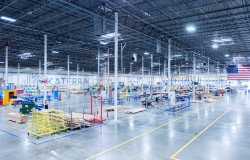A recent survey of UK construction executives by law firm Clyde & Co revealed very low investment to date in offsite manufacturing, and few expectations that offsite would have much impact within five to 10 years.
The findings come as non-traditional players in the US and UK are making bold moves into offsite construction in response to pent-up demand.
Clyde & Co also warned that the established contracting business model is poorly suited to offsite. It raises the question: will the industry, as it is currently constituted, have a role in a future where various types of buildings are made in factories?
Some in the industry are worried.
"We need to undertake a radical digital transformation or we could be wiped out when the Amazon, Google or Tesla of construction comes along," Steve Fozard, head of supply chain for the water sector at Costain, told Clyde & Co for its report.
Other luminaries echoed his unease, such as Toby Uppington, director of strategic planning for Aecom. "The huge disruptive change at the moment, because of the focus on technology, means that the OSM [offsite manufacturing] market is in a 'sweet spot' which companies can capitalise on," he told Clyde & Co.
New markets, new players
Two main factors comprise Uppington's sweet spot. One is the emergence of new housing markets in the form of social provision and private build to rent. In each case the clients' need for speed of delivery and whole-life quality means they are keener on offsite than housebuilders have been to date.
This market logic is visible in Croydon, where the world's tallest modular towers are now going up at 101 George Street. At 37 and 44 storeys respectively, they were commissioned by an outsider to the UK housing scene: the US build-to-rent developer, Greystar. They are being built by Tide Construction with volumetric modules supplied by Tide's associate company, Vision Modular Systems. Together, the towers will have 546 apartments.
Betting on the capital's vast pent-up demand for housing, Greystar plans to build 10,000 apartment units in London by 2022.
The second factor comprising the sweet spot is the willingness of outsiders to apply technology to construction. In the US, eyes are on the Silicon Valley start-up, Katerra, founded in 2015 by a group of real estate and technology chiefs.
Working with engineered timber, Katerra has a standard kit of building components for erecting multi-storey residential and other buildings in whatever configuration clients want. Sales, design, manufacturing, logistics and erection are all managed by an information technology system that incorporates BIM.
The company has raised $1.2bn (€1.06bn) in venture capital funding so far, according to Crunchbase, including $865m (€761m) in a funding round led by the SoftBank Vision Fund in January this year.
It is using the cash to build factories around the US, and to buy up architectural firms and general contractors to bring all necessary skills in house.
It claims to have $3.7bn (€3.25bn) worth of building orders so far and, although there have been reports of teething problems in its production model, it is still capturing developers' imaginations.
So, Fozard's fear of a "Google of construction", that could storm the stage with capital, technology and a business model that clients love, is not so implausible.
Revolution/avoidance
Clyde & Co's report, however, suggests a low level of concern among traditional industry actors. The firm surveyed some 30 executives from the UK's top 50 construction firms, and found much lip service but little action when it comes to offsite.
For instance, 62% of them "agree entirely" that offsite "has the potential to fundamentally transform the construction industry" and 68% said they were considering the use of new and emerging construction-related technology "very seriously".
But 71% of executives reported investing just 0-5% of revenue in developing offsite in the last five years. The bulk of those, 55%, pegged their investment at 0-2% in the time frame. Asked when they expected offsite technology to have a material impact on their organisation's productivity, most (62%) pushed it out to five-to-10 years, somewhat beyond current business planning cycles.
Invited to nominate the biggest barriers to offsite, the top two - cost, and lack of relevant knowledge in their companies - are within their remit to influence. Other factors they listed signal the industry's passivity. They are, in order: waiting for broader roll out across industry; increased risk; unavailable technology; and resistance from the board.
Who will be in charge?
It may not matter. Clyde & Co raises an awkward question: What if main contractors, as they are currently constituted, have no obvious role in a future industry where houses, apartment blocks, schools and colleges, offices, healthcare buildings and prisons are delivered mainly by OSM?
The firm asks because OSM disrupts the traditional contracting business model by shifting the value of a project to a factory. Now, a contractor charges a premium for coordinating the site-based processes but, under OSM, where "pre-manufactured value", or PMV, starts dominating the overall project cost, what is left for the contractor to do, beyond enabling works and assembly?
"Such a shift sits uneasily with a traditional design and build approach," the Clyde & Co authors write, adding: "It is questionable why a developer should pay such a premium when most activity and risk resides instead in the PMV, and is outside the control and expertise of a traditional contractor."
Original link - BIM Plus








